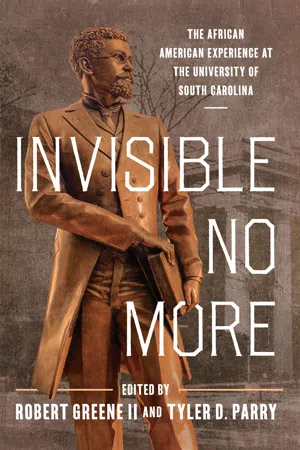
Invisible No More
The African American Experience at the University of South Carolina
- 224 pages
- English
- PDF
- Available on iOS & Android
Invisible No More
The African American Experience at the University of South Carolina
About this book
Since its founding in 1801, African Americans have played an integral, if too often overlooked, role in the history of the University of South Carolina. Invisible No More seeks to recover that historical legacy and reveal the many ways that African Americans have shaped the development of the university. The essays in this volume span the full sweep of the university's history, from the era of slavery to Reconstruction, Civil Rights to Black Power and Black Lives Matter. This collection represents the most comprehensive examination of the long history and complex relationship between African Americans and the university.
Like the broader history of South Carolina, the history of African Americans at the University of South Carolina is about more than their mere existence at the institution. It is about how they molded the university into something greater than the sum of its parts. Throughout the university's history, Black students, faculty, and staff have pressured for greater equity and inclusion. At various times they did so with the support of white allies, other times in the face of massive resistance; oftentimes, there were both.
Between 1868 and 1877, the brief but extraordinary period of Reconstruction, the University of South Carolina became the only state-supported university in the former Confederacy to open its doors to students of all races. This "first desegregation, " which offered a glimpse of what was possible, was dismantled and followed by nearly a century during which African American students were once again excluded from the campus. In 1963, the "second desegregation" ended that long era of exclusion but was just the beginning of a new period of activism, one that continues today. Though African Americans have become increasingly visible on campus, the goal of equity and inclusion—a greater acceptance of African American students and a true appreciation of their experiences and contributions—remains incomplete. Invisible No More represents another contribution to this long struggle.
A foreword is provided by Valinda W. Littlefield, associate professor of history and African American studies at the University of South Carolina. Henrie Monteith Treadwell, research professor of community health and preventative medicine at Morehouse School of Medicine and one of the three African American students who desegregated the university in 1963, provides an afterword.
Frequently asked questions
- Essential is ideal for learners and professionals who enjoy exploring a wide range of subjects. Access the Essential Library with 800,000+ trusted titles and best-sellers across business, personal growth, and the humanities. Includes unlimited reading time and Standard Read Aloud voice.
- Complete: Perfect for advanced learners and researchers needing full, unrestricted access. Unlock 1.4M+ books across hundreds of subjects, including academic and specialized titles. The Complete Plan also includes advanced features like Premium Read Aloud and Research Assistant.
Please note we cannot support devices running on iOS 13 and Android 7 or earlier. Learn more about using the app.
Information
Table of contents
- Cover
- INVISIBLE NO MORE
- Title
- Copyright
- Contents
- List of Illustrations
- Acknowledgments
- Foreword
- Introduction
- Chapter One Slavery on Campus: Examining the Lived Experiences of Enslaved People at South Carolina College
- Chapter Two “Irrespective of Race or Color”: Examining Desegregation at the Reconstructed University of South Carolina, 1868–1877
- Chapter Three Richard T. Greener at the Reconstruction-Era University: Professor, Librarian, and Student
- Chapter Four Laying the Mountains Low: The Life and Education of Simon Peter Smith, 1845–1914
- Chapter Five Struggle for Educational Access in South Carolina, 1865–1890
- Chapter Six Before 1963: Race, Education, and the NAACP Desegregation Campaigns at the University of South Carolina
- Chapter Seven The Legacy of Desegregation: USC and Its Changing Campus and Student Body since the 1960s
- Chapter Eight Peace, Love, Education, and Liberation: The Black Campus Movement at the University of South Carolina
- Chapter Nine “What’s Next, Southern Fried Chicken?” Confederate Memory and Racial Violence at the Postintegration University
- Chapter Ten “The Right Time”: Performing Public History at the University of South Carolina, 2010–2020
- Conclusion
- Afterword
- Notes
- Selected Bibliography
- Index
- About the Editors